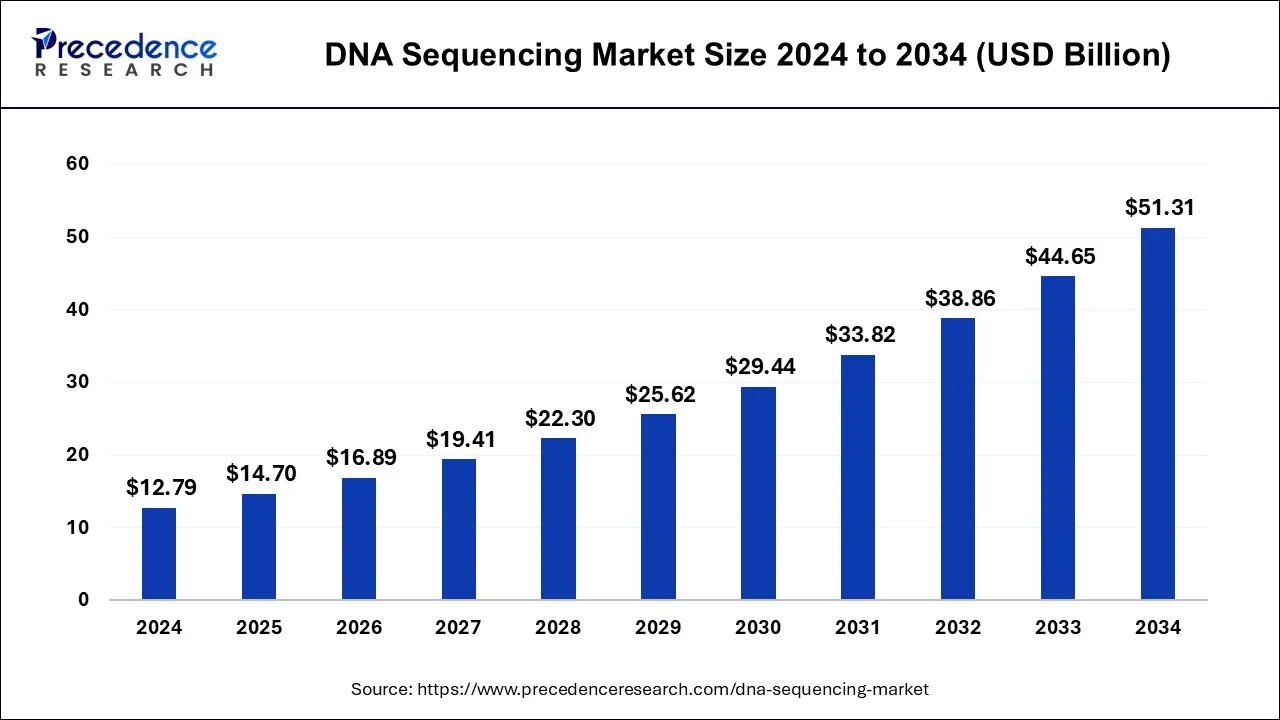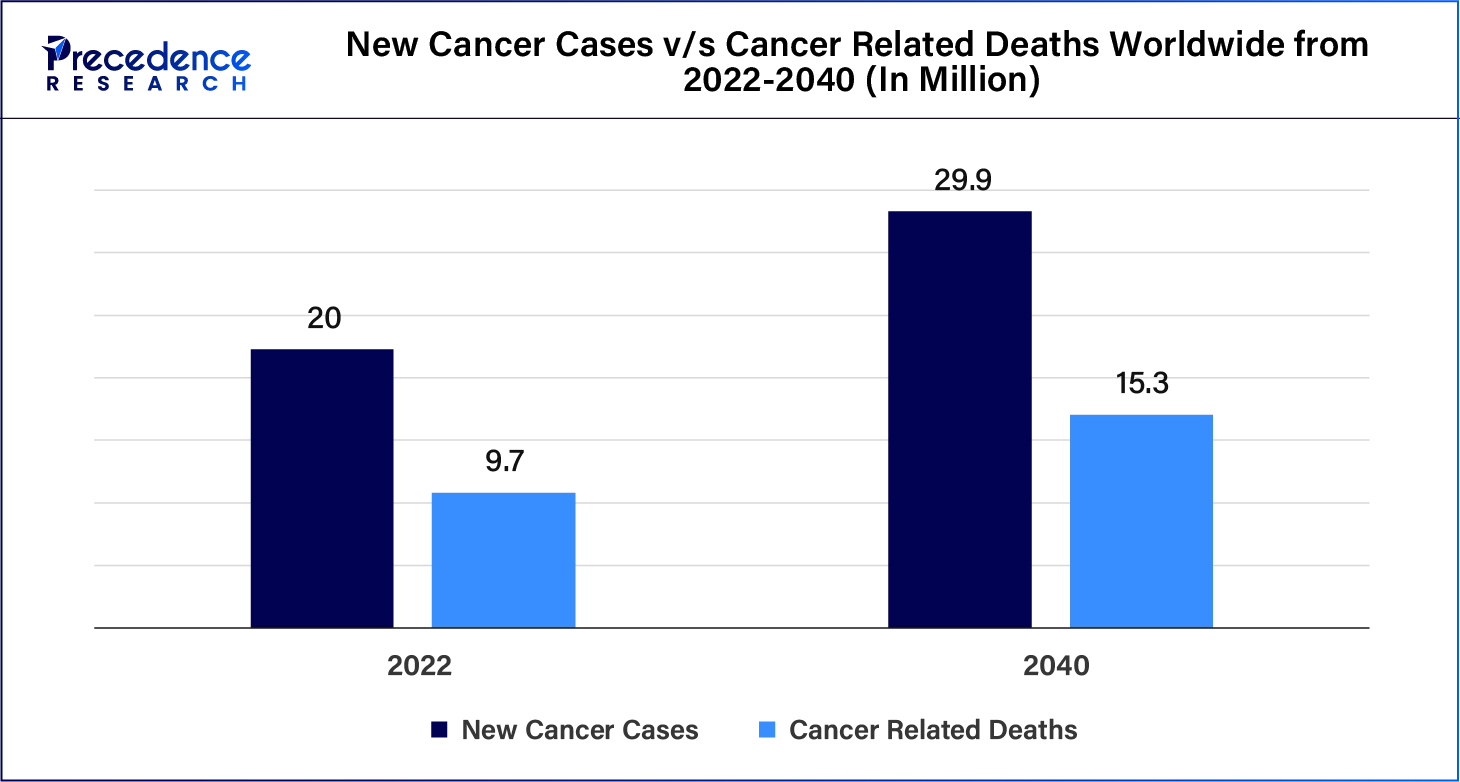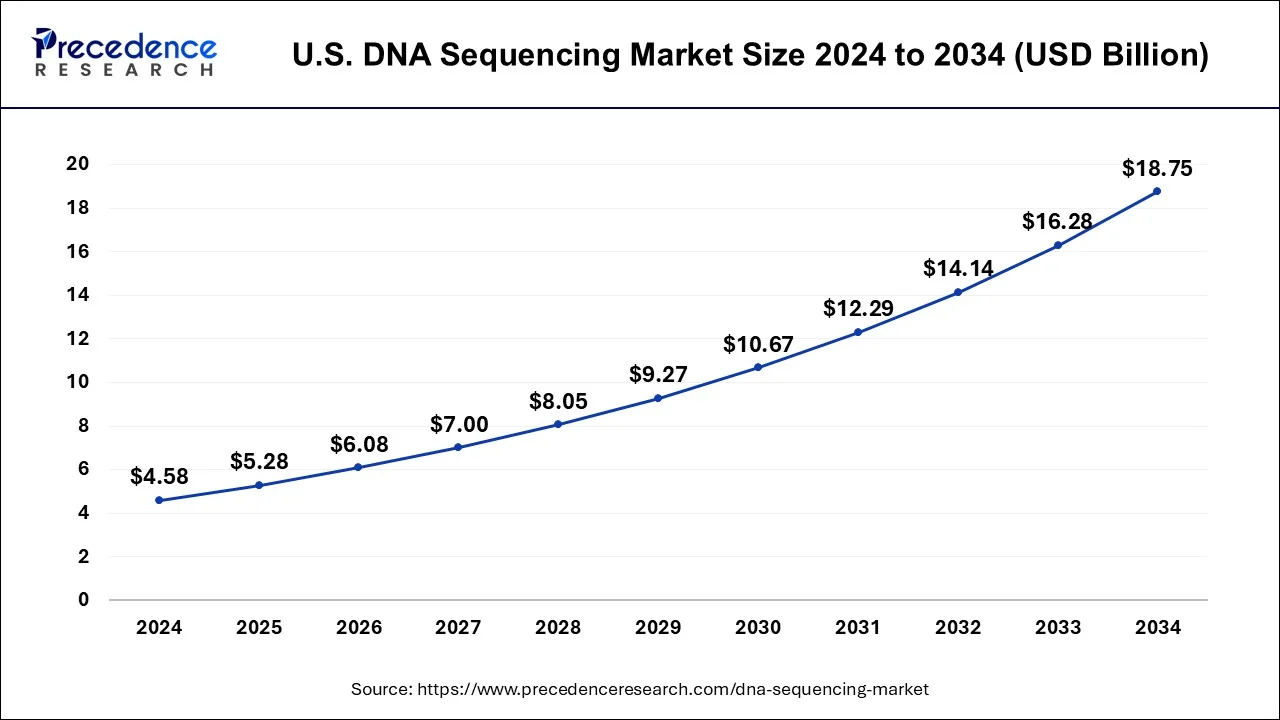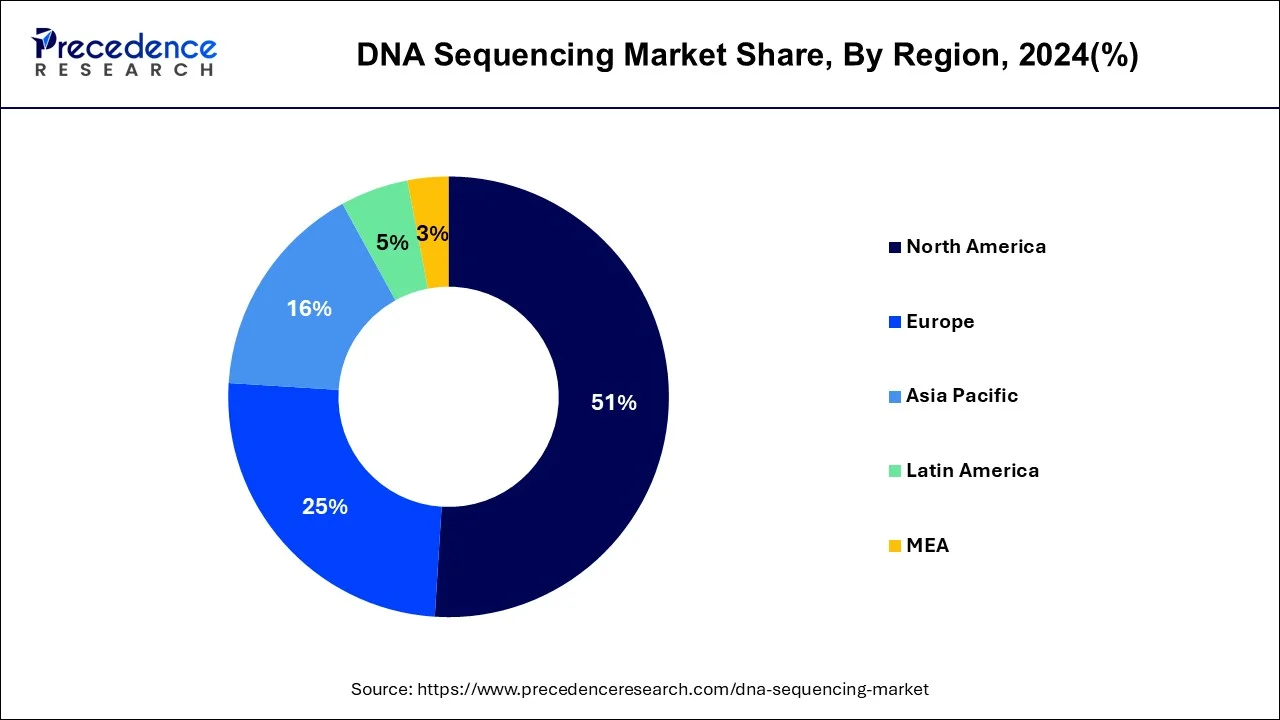List of Contents
What is the DNA Sequencing Market Size?
The global DNA sequencing market size is USD 14.70 billion in 2025, accounted for USD 16.89 billion in 2026, and is expected to reach around USD 51.31 billion by 2034, expanding at a CAGR of 14.90% from 2025 to 2034.

Market Highlights
- North America led the global market with the highest market share of 51% in 2024.
- By Product, the Consumables segment has held the largest market share in 2024.
- By Technology, the next-generation sequencing segment captured the biggest revenue share in 2024.
- By Application, the Oncology segment captured the biggest revenue share in 2024.
- By End-Use, the Academic Research segment is estimated to hold the highest market share in 2024.
Market Size and Forecast
- Market Size in 2025: USD 14.70 Billion
- Market Size in 2026: USD 16.89 Billion
- Forecasted Market Size by 2034: USD 51.31 Billion
- CAGR (2025-2034): 14.90%
- Largest Market in 2024: North America
- Fastest Growing Market: Asia Pacific
DNA Sequencing Market Overview: Decoding the Market
The fast development of DNA sequencing technology is providing scientists with the capability to generate information about genetic variation and outlines of gene expression on an unparalleled scale. The DNA sequencing technology is expected to allow scientists in achieving accurate sequencing of whole human genomes within just a few years. This technology will become a routine tool for scientists and clinicians. Numerous sequencing platforms presently in development have the potential to present greater advances in resolution and throughput. The massively parallel sequencing technologies are at present altering almost all fields of genetics, and the field of pharmacogenomics will be no exemption. The most predominant application of the new sequencing technologies in the field of pharmacogenomics is the detection of novel genetic variations that might influence drug response.
DNA Sequencing MarketGrowth Factors
- Increasing prevalence of cancer
- Technological advances in next-generation sequencing technologies
- Rising demand for precision medicine
- Declining costs of sequencing
- High investment in research and development
DNA Sequencing Market Outlook: The Emerging Opportunities
- Industry Growth Overview: The expanding application and growing technological advances are driving the industrial growth in the market.
- Major Investors: Large institutional and venture capital firms like Orbimed, IP Group, and Redmile Group etc. are the major investors in the market.
- Startup Ecosystem: The startup ecosystem is focusing on innovations to enhance the speed, accuracy, and accessibility of DNA sequencing across various research applications.
Market Scope
| Report Highlights | Details |
| Market Size in 2025 | USD 14.70 billion |
| Market Size in 2026 | USD 16.89 billion |
| Market Size by 2034 | USD 51.31 billion |
| Growth Rate from 2025 to 2034 | CAGR of 14.9% |
| Largest Market | North America |
| Fastest Growing Market | Asia Pacific |
| Base Year | 2025 |
| Forecast Period | 2025 to 2034 |
| Segments Covered | Product, technology, Application, and End Use |
| Regions Covered | North America, Europe, Asia-Pacific, Latin America, and Middle East & Africa |
Segments Insights
Product Insights
The consumables segment held the largest share of the DNA sequencing market in 2024. A vast range of goods, including kits, reagents, and other supplies necessary for various sequencing technologies, are referred to as sequencing consumables when discussing DNA sequencing techniques. The need for these consumables has increased due to the continual advancements in genomics and sequencing methods. In particular, the need for specialized consumables has expanded due to the widespread use of next-generation sequencing (NGS) technology in clinical diagnosis, research, and personalized medicine. Prominent industry players provide a variety of products designed to be compatible with different sequencing systems. It is projected that as genomics plays an increasingly significant role in biomedical research and healthcare, the market for sequencing consumables will expand gradually.
Technology Insights
The next-generation sequencing segment dominated the DNA sequencing market in 2024. In genomics research, next-generation sequencing (NGS) is a potent instrument. Millions of DNA fragments can be sequenced simultaneously by NGS, yielding comprehensive data on genome structure, genetic variants, gene activity, and behavioral changes in genes. The main goals of recent developments have been to improve data analysis, lower expenses, and sequence data more quickly and accurately. These developments have enormous potential to improve our understanding of diseases and tailored therapy by revealing fresh insights into genetics.
Application Insights
The oncology segment held the largest share of the DNA sequencing market in 2024. Sequential sequencing is also very important in the study of cancer. Thousands of tumor tissue samples are being sequenced as part of projects like The Cancer Genome Atlas in an effort to identify the specific genetic abnormalities that promote the growth of different cancer types. Researchers can also follow the evolution of a cancer's genetic makeup through sequencing. Researchers want to understand how cancer responds to treatment and may develop resistance to it by, for example, sequencing the DNA of a tumor before and after treatment.

20 million new instances of cancer and 9.7 million cancer-related deaths are expected in 2022, according to WHO projections. Five years after receiving a cancer diagnosis, an estimated 53.5 million people would still be alive. At some point in their lives, one in five people will be affected by cancer. The illness claims the lives of about 1 in 9 males and 1 in 12 women. Lung cancer is the most frequent cancer, making up 12.4% of all new cases, with 2.5 million new cases worldwide. The following in incidence order were female breast cancer (2.3 million cases, 11.6%), colon cancer (1.9 million cases, 9.6%), stomach cancer (970,000 cases, 4.9%), and prostate cancer (1.5 million cases, 7.3%).
End-Use Insights
The academic research segment dominated the DNA sequencing market in 2024. The methodical study of a research problem or scenario with the goal of finding facts to address the issue or find a solution is known as academic research. The increase of academic research is attributed to various factors, including government efforts and considerable expenditure in research and development in the field of DNA sequencing.
Regional Insights
U.S. DNA Sequencing Market Size and Growth 2025 to 2034
The U.S. DNA sequencing market size is estimated at USD 5.28 billion in 2025 and is predicted to be worth around USD 18.75 billion by 2034, at a CAGR of 15.14% from 2025 to 2034.

North America dominated the DNA sequencing market in 2024. North America is the leader in the DNA sequencing market due to several factors, including significant firms' ongoing technological development, strong R&D investment, and the availability of technologically advanced healthcare infrastructure. Research on cancer treatments and medication development is supported by several government programs in the U.S. and Canada. These nations are seeing rapid growth in the biotechnology sector, which is resulting in more alternatives for treatments and diagnostics.
Audacious objectives for the U.S. bioeconomy include figuring out the function of at least 80% of recently found genes and sequencing the genomes of one million microbial species in five years. The National Science Foundation in the United States has been investing in biotechnology for decades, allowing the utilization of living organisms to produce goods and services that benefit society and speeding up scientific discovery.

The Canadian government is putting great effort into reviving the country's biomanufacturing industry in order to provide Canadians with effective and safe therapies. In order to strengthen Canada's vaccination, biotechnology, pharmaceuticals, and biomanufacturing capabilities, more than $2.1 billion has been committed since March 2020. The Strategic Innovation Fund (SIF) will receive a $23 million investment from the Honourable Mary Ng, Minister of Innovation, Science and Industry, International Trade and Economic Development, to support Edesa Biotech's $61 million project.
Asia Pacific is expected to grow at the fastest rate during the forecast period. Strategic business expansion is driven by international enterprises' expanding consumer base. Furthermore, in the Asia-Pacific area, the Indian market for DNA sequencing was increasing at the fastest rate, while the Chinese market had the biggest market share.
Government Support Accelerates the Europe Market
Europe is expected to grow significantly in the DNA sequencing market during the forecast period, due to growing government initiatives which driving the investments in the DNA sequencing products. The expanding industries, technological innovations, are also increasing their use for the diagnosis of diseases and precision medicine development.
The R&D Drives UK innovations
The presence of strong R&D infrastructure in the UK is increasing the use of DNA sequencing in various industries and institutions. Their use is also supported by government initiatives, where the healthcare systems are also leveraging them for rare diseases and cancer diagnosis. Moreover, new DNA sequencing tools are also being developed by the companies.
Healthcare Growth Propels South America
South America is expected to grow significantly in the DNA sequencing market during the forecast period, expanding healthcare is increasing its use for genomics and precision medicine development. Additionally, the companies are collaborating to develop advanced technology with enhanced accuracy, where the growing incidence of cancer is driving their demand.
Growing Applications Fuel Brazil's Growth
The use of DNA sequencing in Brazil is increasing due to its growing application in oncology, genomics, pharma genomics, and diagnosis. Moreover, the growing investments are driving their adoption and accelerating their innovations. Moreover, they are also being used in the industries and institutions for R&D purposes.
DNA Sequencing Market Value Chain Analysis: Uncovering Innovations
- R&D The R&D of DNA sequencing focuses on the development of long-read and single-cell multi-omics technologies with the use of advanced technologies.
Key players: Illumina, Inc., Thermo Fisher Scientific, MGI Tech. - Clinical Trials and Regulatory ApprovalsSuccessful results of analytical and clinical validity for diagnostic tests are required for the clinical trials and regulatory approval of the DNA sequencing.
Key players: Illumina, Inc., Thermo Fisher Scientific - Patient Support and ServicesGenetic counseling, educational resources, and financial assistance programs are involved in the patient support and services of DNA sequencing.
Key players: MedGenome, Illumina, Inc., Thermo Fisher Scientific.
Key players in DNA Sequencing Market and their Offerings
- Illumina, Inc.: NovaSeq X Series, NextSeq, MiSeq, and iSeq 100 are provided by the company.
- QIAGEN: Different types of products of the NGS workflow are provided by the company.
- Perkin Elmer: BioQule NGS Systems and NEXTFLEX Library Prep Kits are provided by the company.
- Thermo Fisher Scientific: The company provided products like the Ion GeneStudio S5 System and Ion Torrent Genexus System,
- Oxford Nanopore Technologies Ltd.: MinION and PromethION are offered by the company.
Segments Covered in the Report
By Product
- Instruments
- Consumables
- Services
By Technology
- Third Generation DNA Sequencing
- Next-Generation Sequencing
- Sanger Sequencing
By Application
- Clinical Investigation
- Oncology
- Forensics & Agrigenomics
- Reproductive Health
- HLA Typing
- Others
By End-Use
- Clinical Research
- Academic Research
- Biotechnology & Pharmaceutical Companies
- Hospitals & Clinics
- Others
By Region
- North America
- Europe
- Asia Pacific
- Latin America
- Middle East & Africa
For inquiries regarding discounts, bulk purchases, or customization requests, please contact us at sales@precedenceresearch.com
Frequently Asked Questions
Ask For Sample
No cookie-cutter, only authentic analysis – take the 1st step to become a Precedence Research client



